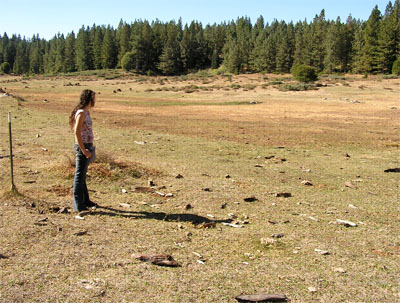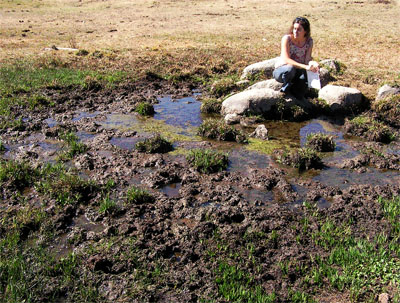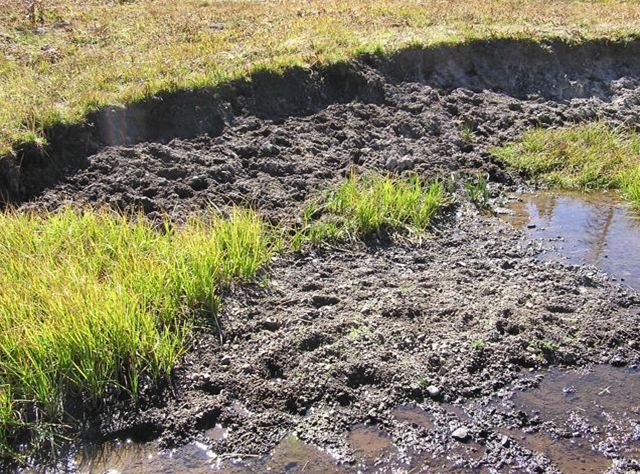Sierra Nature Notes, Volume 9, February 2010
Poorly managed livestock grazing causes major impacts
to water, wildlife, and recreation on the Stanislaus Forest
Central
Sierra Environmental Resource Center (CSERC)
 |
"Acceptable"
level of grazing by cattle: Stanislaus National Forest. |
At the end of the grazing season of October 2008, CSERC staff stood with
three Forest Service officials and the range permittee at the meadow shown
above. We pointed out that the meadow was overgrazed and that cows
were still grazing in the meadow a week after all cows were supposed to be
off that allotment. We showed them the spring (below) and the pocking
and trampling all across it added to the pollution from cattle wastes. In
response, the Forest officials looked around and told us that they didn’t
see any problems. They claimed that all the impacts were within acceptable
limits. One official said, “The grass will grow back next year.
What it looks like now isn’t what we’re concerned about.”
 |
Spring
showing pocking and trampling by cattle: Stanislaus Natinal Forest |
For years, CSERC staff scientists and other staff members have visited meadows before cows come on and after they have grazed for most of the summer/fall season. Again and again CSERC has found riparian areas heavily over-grazed, stream banks chiseled by cattle hooves, and wildlife habitat severely degraded. For a number of years, all that information has been given to Forest officials in a detailed report. Yet Forest officials refuse to stop the damage, to reduce the numbers of cows in over-grazed areas, or to strictly follow Regional regulations that are intended to protect fens, springs, streams, riparian areas, and wet meadows. For riparian plants, at-risk amphibians, and other wildlife species, it is long past time to halt grazing abuses in the Stanislaus Forest.
One of the biggest impacts from livestock grazing is the harm caused to water quality. Literally thousands of recreational visitors come to the Stanislaus National Forest each year for backpacking, camping, hiking, hunting, fishing, or other recreational uses. Many of those visitors drink from streams.
Dr. Robert Derlet of the UC Davis School of Medicine, has been studying Sierra water quality for many years. Among his conclusions:
Since the Sierra Nevada mountains serve as the watershed for over 50% of California’s drinking water, it is hard to imagine why the Forest Service dismissed concerns about water quality that were raised in public comments for a grazing management plan in popular recreation areas of the local mountains. The agency suggested that water quality shouldn’t be a problem because even if livestock contaminated water, recreational visitors would use filters for their drinking water. From the environmental perspective, e coli and other pollutants shouldn’t be permitted in public forest waters, whether or not visitors filter their water.
 |
Raparian
area showing signs of trampling and stream bank erosion by cattle:
Stanislaus National Forest |
The bottom line for the forest ecosystem is that livestock grazing causes a loss of habitat value for a wide range of wildlife species. Grazing contaminates water, it erodes stream banks, it leads to erosion that de-waters meadows, and grazing interferes with many kinds of recreation. The fact that livestock grazing also causes a huge loss to taxpayers each year on top of all the environmental damage underscores the logic of scaling back grazing to a level that causes less harm.
Further Reading
Rangeland cattle and the risk of waterborne Cryptosporidium parvum infection in humans
Rob Atwill, DVM, PhD
Algae
in the Sierra Nevada Wilderness areas
Robert W. Derlet, M.D.
Kemal Ali Ger, Ph.D.
Central Sierra Environmental Resource Center (CSERC) web site.
Reducing
the impact of summer cattle grazing on water quality in the Sierra Nevada
Mountains of California: a proposal
Journal of Water and Health In
Press, Uncorrected Proof © IWA Publishing 2009 | doi:10.2166/wh.2009.171
Robert W. Derlet, Charles Goldman and Michael J. Connor
Water
quality and the grazing animal
R.
K. Hubbard*,2,
G. L. Newton and
G. M. Hill
and
G. M. Hill
*
Southeast Watershed Research Laboratory, USDA-ARS, Tifton, GA 31793 and and Department
of Animal and Dairy Science, University of Georgia, Tifton 31793
Investigator's
Annual Report
National Park Service, Yosemite Packstock and Microbial Water Quality Project,
Principal Investigator: Mr Edward Atwill
2001, 2002, 2003, 2004
Our Founder Questions? Go to About Our New Site |
Masthead
Photo from: |